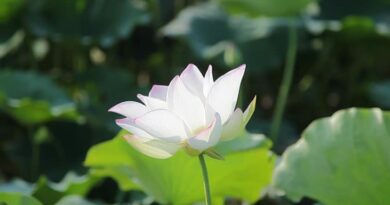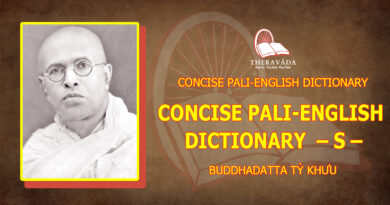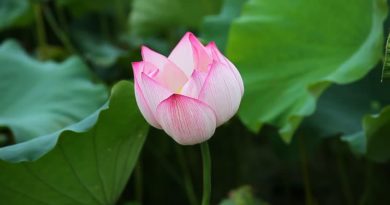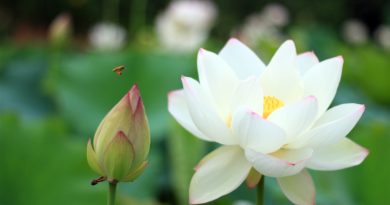Going For Refuge & Taking The Precepts – Identification Of The Objects Of Refuge – Iii. Bhikkhu Bodhi
III. IDENTIFICATION OF THE OBJECTS OF REFUGE
The fruitfulness of the act of taking refuge is proportional to the depth and precision with which we understand the nature of the refuge-objects. Therefore these objects have to be identified with precision and correctly understood. Each refuge-object has a double layer of signification, one concrete and mundane, the other intangible and supramundane. The two are not entirely distinct, but intermesh in such a way that the former acts as a vehicle for the latter. An examination of each refuge in turn will make clear what their twofold signification is and how they interfuse.
The Buddha as refuge can be considered first. On one level the word “Buddha” refers to a particular figure — the man Siddhattha Gotama who lived in India in the fifth century B.C. When we take refuge in the Buddha, we take refuge in this person, for he is the teacher of the Dhamma and the historical founder of Buddhism. However, in going to him for refuge, we do not take refuge in him merely in his concrete particularity. We rely upon him as the Buddha, the enlightened one, and this has a significance transcending the limits of what can be given by empirical, historical fact. What enables the Buddha to function as a refuge is his actualization of a supramundane attainment. This attainment is the state of Buddhahood or perfect enlightenment, a state which has been realized by other persons in the past and will be realized again in the future. Those who realize this state are Buddhas. When we take refuge in the Buddha we rely upon him as a refuge because he embodies this attainment in himself. It is his Buddhahood that makes the Buddha a refuge.
But what is the Buddhahood of the Buddha? In brief the Buddhahood of the Buddha is the sum total of the qualities possessed by that person named Gotama which make him a Buddha. These qualities can be summed up as the abandonment of all defects and the acquisition of all virtues.
The defects abandoned are the defilements (kilesa) together with their residual impressions (vasana). The defilements are afflictive mental forces which cause inner corruption and disturbance and motivate unwholesome actions. Their principle members are greed, hatred, and delusion; from these all the secondary defilements derive. In the Buddha these defilements have been abandoned totally, completely, and finally. They are abandoned totally in that all defilements have been destroyed with none remaining. They are abandoned completely in that each one has been destroyed at the root, without residue. And they have been abandoned finally in that they can never arise again in the future.
The virtues acquired by the Buddha are very numerous, but two stand out as paramount: great wisdom (mahapañña) and great compassion (maha-karuna). The great wisdom of the Buddha has two aspects — extensiveness of range and profundity of view. Through the extensive range of his wisdom the Buddha understands the totality of existent phenomena; through his profundity of view he understands the precise mode of existence of each phenomenon.
The Buddha’s wisdom does not abide in passive contemplation but issues in great compassion. Through his great compassion the Buddha comes forth to work for the welfare of others. He takes up the burden of toiling for the good of sentient beings, actively and fearlessly, in order to lead them to deliverance from suffering.
When we go for refuge to the Buddha we resort to him as the supreme embodiment of purity, wisdom and compassion, the peerless teacher who can guide us to safety out of the perilous ocean of samsara.
The Dhamma too involves a double reference. At the elementary level the word “Dhamma” signifies the teaching of the Buddha — the conceptually formulated, verbally expressed set of doctrines taught by or deriving from the historical figure Gotama. This teaching, called “the transmission” (agama), is contained in the Tipitaka or three collections of scripture and in the commentaries and expository works which explain them. The three collections are the Vinayapitaka, the Suttapitaka, and the Abhidhammapitaka. The Vinayapitaka collects together all the monastic rules and regulations detailing the discipline for Buddhist monks and nuns. The Suttapitaka contains the discourses of the Buddha expounding his doctrine and the practice of his path. The Abhidhammapitaka presents an exposition of the sphere of actuality from the standpoint of a precise philosophical understanding which analyzes actuality into its fundamental constituting elements and shows how these elements lock together through a network of conditional relations.
The verbally transmitted Dhamma contained in the scriptures and commentaries serves as the conduit to a deeper level of meaning communicated through its words and expressions. This is the Dhamma of actual achievement (adhigama), which comprises the path (magga) and the goal (attha). The goal is the final end of the teaching, nibbana, the complete cessation of suffering, the unconditioned state outside and beyond the round of impermanent phenomena making up samsara. This goal is to be reached by a specific path, a course of practice bringing its attainment, namely the noble eightfold path — right views, right intentions, right speech, right action, right livelihood, right effort, right mindfulness, and right concentration. The path divides into two stages, a mundane path and a supramundane path. The mundane path is the course of application developed when its factors are cultivated in daily life and in periods of intensified practice. The supramundane path is a state of wisdom-consciousness that arises when all the requisite conditions for realization are fully matured, usually at the peak of intensified practice. This path actually represents a state in the experience of enlightenment, having the dual function of realizing nibbana and eradicating defilements.
The supramundane path comes only in momentary breakthroughs which, when they occur, effect radical transformations in the structure of the mind. These breakthroughs are four in number, called the four paths. The four divide according to their ability to cut the successively subtler “fetters” causing to samsara. The first path, the initial breakthrough to enlightenment, is the path of stream-entry (sotapattimagga), which eradicates the fetters of ego-affirming views, doubt, and clinging to rites and wrong observances. The second, called the path of the once-returner (sakadagamimagga), does not cut off any fetters but weakens their underlying roots. The third, the path of the non-returner (anagamimagga), eliminates the fetters of sensual desire and ill-will. And the forth, the path of arahatship (arahattamagga), eradicates the five remaining fetters — desire for existence in the spheres of fine material and immaterial being, conceit, restlessness, and ignorance. Each path-moment is followed immediately by several moments of another supramundane experience called fruition (phala), which comes in four stages corresponding to the four paths. Fruition marks the enjoyment of the freedom from defilement effected by the preceding path-moment. It is the state of release or experiential freedom which comes when the fetters are broken.
Earlier it was said that the Dhamma is the actual refuge. In the light of the distinctions just drawn this statement can now be made more precise. The verbal teaching is essentially a map, a body of instructions and guidelines. Since we have to rely on these instructions to realize the goal, the teaching counts as an actual refuge, but it is so in a derivative way. Thus we can call it an actual but indirect refuge. The mundane path is direct, since it must be practiced, but because it serves principally as preparation for the supramundane path its function is purely provisional; thus it is an actual and direct but provisional refuge. The supramundane path apprehends nibbana, and once attained leads irreversibly to the goal; thence it may be called an actual, direct, and superior refuge. However, even the supramundane path is a conditioned phenomenon sharing the characteristic of impermanence common to all conditioned phenomena. Moreover, as a means to an end, it possesses instrumental value only, not intrinsic value. Thus its status as a refuge is not ultimate. Ultimate status as a refuge belongs exclusively to the goal, to the unconditioned state of nibbana, which therefore among all three refuges can alone be considered the refuge which is actual, direct, superior, and ultimate. It is the final resort, the island of peace, the sanctuary offering permanent shelter from the fears and dangers of samsaric becoming.
At the conventional or mundane level the Sangha signifies the Bhikkhu-Sangha, the order of monks. The Sangha here is an institutional body governed by formally promulgated regulations. Its doors of membership are open to any candidate meeting the required standards. All that is needed to enter the Sangha is to undergo ordination according to the procedure laid down in the Vinaya, the system of monastic discipline.
Despite its formal character, the order of monks fulfills an indispensable role in the preservation and perpetuation of the Buddha’s dispensation. In an unbroken lineage extending back over twenty-five hundred years, the monastic order has served as the custodian of the Dhamma. The mode of life it makes possible permits it to exercise this function. The Buddha’s dispensation, as we suggested, possesses a twofold character; it is a path of practice leading to liberation from suffering, and also a distinctive set of doctrines embedded in scriptures expounding the details of this path. The Sangha bears the responsibility for maintaining both aspects of the dispensation. Its members assume the burden of continuing the tradition of practice with the aim of showing that the goal can be realized and deliverance attained. They also take up the task of preserving the doctrines, seeing to it that the scriptures are taught and transmitted to posterity free from distortion and misinterpretation.
For these reasons the institutional Sangha is extremely vital to the perpetuation of the Buddha’s teaching. However, the order of monks is not itself the Sangha which takes the position of the third refuge. The Sangha which serves as refuge is not an institutional body but an unchartered spiritual community comprising all those who have achieved penetration of the innermost meaning of the Buddha’s teaching. The Sangha-refuge is the ariyan Sangha, the noble community, made up exclusively of ariyans, person of superior spiritual stature. Its membership is not bound together by formal ecclesiastical ties but by the invisible bond of a common inward realization. The one requirement for admission is the attainment of this realization, which in itself is sufficient to grant entrance.
Though the way of life laid down for the monastic order, with its emphasis on renunciation and meditation, is most conducive to attaining the state of an ariyan, the monastic Sangha and the ariyan Sangha are not coextensive. Their makeup can differ, and that for two reasons: first, because many monks — the vast majority in fact — are still worldlings (puthujjana) and thence cannot function as a refuge; and second, because the ariyan Sangha can also include laymen. Membership in the ariyan Sangha depends solely on spiritual achievement and not on formal ordination. Anyone — layman or monk — who penetrates the Buddha’s teaching by direct vision gains admission through that very attainment itself.[2]
The membership of the ariyan Sangha comprises eight types of persons, which unite into four pairs. The first pair consists of the person standing on the path of stream-entry and the stream-enterer, who has entered the way to deliverance and will attain the goal in a maximum of seven lives; the second pair of the person standing on the path of the once-returner and the once-returner, who will return to the human world only one more time before reaching the goal; the third pair of the person standing on the path of the non-returner and the non-returner, who will not come back to the human world again but will take rebirth in a pure heavenly world where he will reach the final goal; and the fourth pair of the person standing on the path of arahatship and the arahant, who has expelled all defilements and cut off the ten fetters causing bondage to samsara.
The eight persons can be divided in another way into two general classes. One consists of those who, by penetrating the teaching, have entered the supramundane path to liberation but still must practice further to arrive at the goal. These include the first seven types of ariyan persons, who are collectively called “trainees” or “learners” (sekha) because they are still in the process of training. The second class comprises the arahats, who have completed the practice and fully actualized the goal. These are called “beyond training” (asekha) because they have no further training left to undertake.
Both the learners and the arahats have directly understood the essential import of the Buddha’s teaching for themselves. The teaching has taken root in them, and to the extent that any work remains to be done they no longer depend on others to bring it to its consummation. By virtue of this inner mastery these individuals possess the qualifications needed to guide others towards the goal. Hence the ariyan Sangha, the community of noble persons, can function as a refuge.









